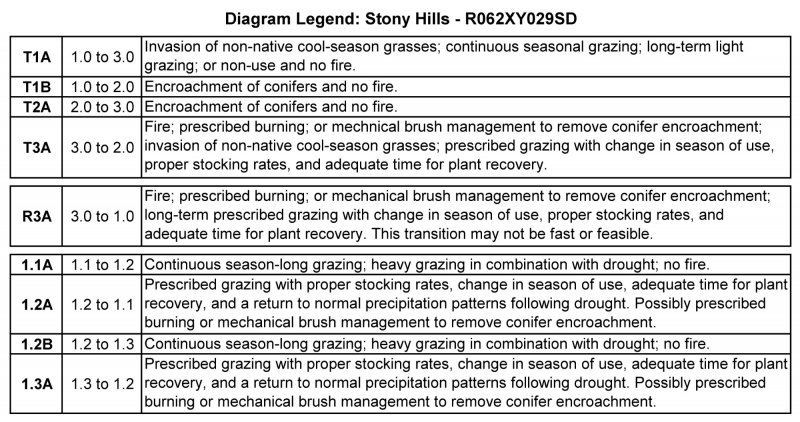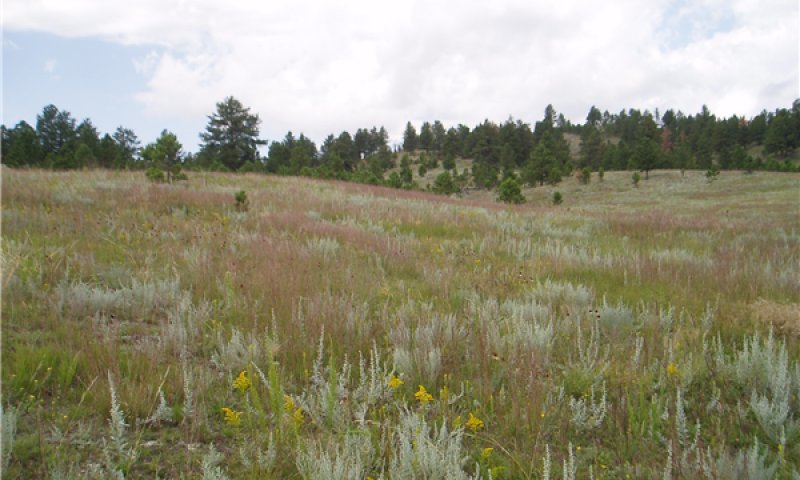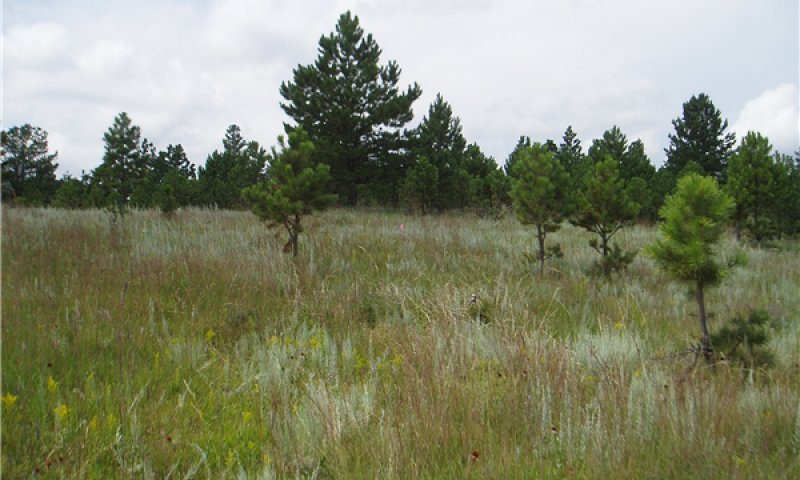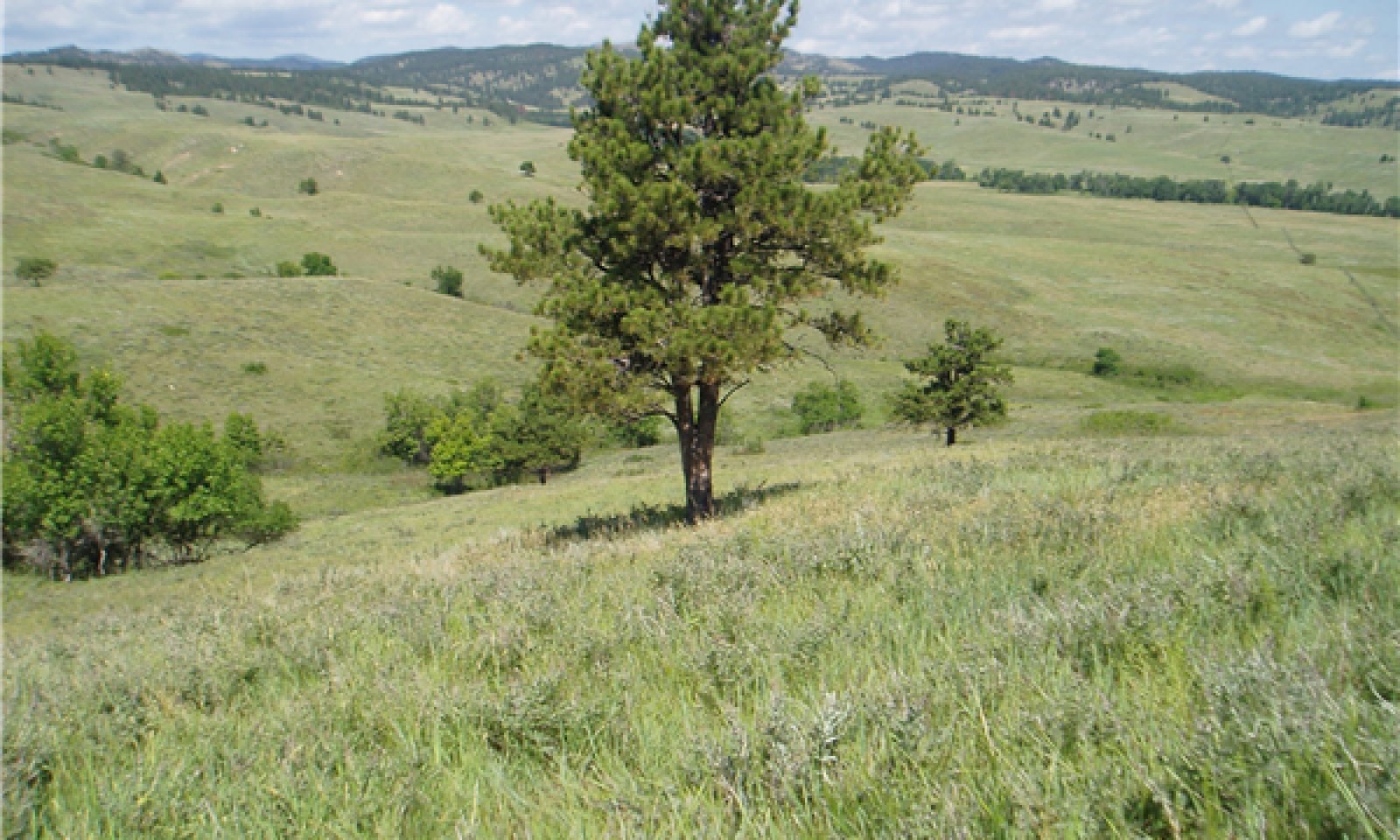

Natural Resources
Conservation Service
Ecological site R062XY029SD
Stony Hills
Last updated: 7/31/2024
Accessed: 04/24/2025
General information
Provisional. A provisional ecological site description has undergone quality control and quality assurance review. It contains a working state and transition model and enough information to identify the ecological site.
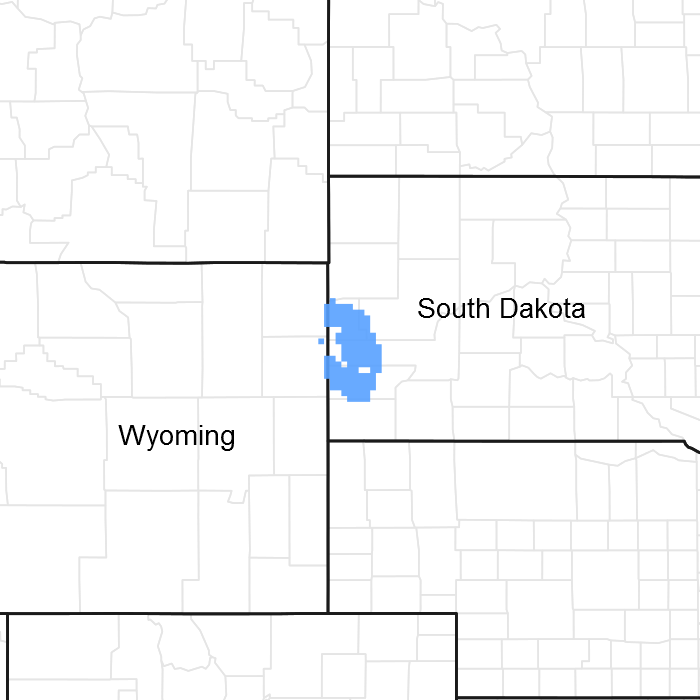
Figure 1. Mapped extent
Areas shown in blue indicate the maximum mapped extent of this ecological site. Other ecological sites likely occur within the highlighted areas. It is also possible for this ecological site to occur outside of highlighted areas if detailed soil survey has not been completed or recently updated.
MLRA notes
Major Land Resource Area (MLRA): 062X–Black Hills
The Black Hills (MLRA 62) is a unique, low lying mountain range situated in the midst of a mixed short and mid-grass prairie. It is a true “Island in the Plains,” as it has geophysical and biological attributes that are unlike the surrounding area. The Black Hills have strong floristic ties to four of the North American biomes: Cordilleran (Rocky Mountain) Forest, Northern Coniferous Forest, Eastern Deciduous Forest, and Grasslands.
MLRA 62 is approximately 3,040 square miles in size; 74 percent is located in South Dakota, and 26 percent is in Wyoming. The towns of Lead, Deadwood, Hill City, and Custer, South Dakota, are in this area. U.S. Highways 16 and 385 cross the MLRA. The Black Hills National Forest, Custer State Park, Mt. Rushmore National Monument, Wind Cave National Park, and Jewel Cave National Monument are located in this MLRA.
This area forms the core of the Black Hills and the Bear Lodge Mountains where the elevation generally ranges between 3,600 to 6,565 feet, however, Black Elk Peak (formerly Harney Peak) rises to 7,242 feet. The slopes vary from moderately sloping on some of the high plateaus to very steeply sloping along drainageways and on peaks and ridges. Narrow valleys generally are gently sloping to strongly sloping.
The Black Hills uplift is the product of the Laramide mountain-building episodes that produced most of the ranges in the Rocky Mountains. Uplift began near the end of the Cretaceous period, 65 million years ago and ended by 35 million years ago (Froiland, 1990). The core of the Black Hills is a plutonic mass of granite with steeply dipping metamorphic rocks, primarily slate and schist, that directly surrounds the granite core. A plateau of Mississippian limestone surrounds the igneous and metamorphic rock core. The Madison limestone is broken around the outer edges of the uplifted area. The Permian Minnekahta limestone forms the outermost boundary of the area. Many other tilted sandstone, shale, and limestone units are exposed like a bathtub ring inside the steeply dipping Madison limestone.
The dominant soil orders in this MLRA are Alfisols (forest soils) and Mollisols (grassland soils). The soils in the area have a frigid or cryic soil temperature regime, a udic or ustic soil moisture regime, and mixed, micaceous, or smectitic mineralogy. They are shallow to very deep, generally are well drained, and are loamy in texture.
The Black Hills MLRA supports open to dense forest vegetation. Ponderosa pine is the dominant species across the Black Hills. White spruce grows at the higher elevations and along the major drainageways. Bur oak is found intermixed with pine in the northern and eastern fringes of the Black Hills, and Rocky Mountain juniper is most common in the southern portion of the Black Hills. Aspen and paper birch are minor components found throughout the Black Hills. Prairie dropseed, roughleaf ricegrass, green needlegrass, poverty oatgrass, Richardson’s needlegrass, slender wheatgrass, and Canada wildrye are the most common native grasses under open forest stands. The most common native shrubs are bearberry, common juniper, grouse whortleberry, poison ivy, and Saskatoon serviceberry.
MLRA 62 land ownership is approximately 47 percent private and 53 percent federal. Rangeland and forestland are split almost equally between private and federal ownership (47 percent each). Minor areas of land are privately owned cropland and urban development. The forestland in this area is used mainly for timber production, recreation, and grazing.
The major resource concerns are soil erosion and surface compaction caused by logging, mining, wildfires, grazing, and urban expansion. The quality of both ground and surface water is another concern, especially in the northern part of the Black Hills. The primary cause for concern is contamination from mine waste and septic systems in areas of rural development and urban expansion (USDA-NRCS, 2006: Ag Handbook 296).
LRU notes
For development of ecological sites, MLRA 62 is divided into three Land Resource Units (LRUs) or physiographic zones (A, B, C, and Y). Each LRU has a set of ecological sites that represents these zones.
The LRU is identified in the Ecological Site ID: R062XY000SD; “062X” identifies the MLRA, and the next letter “Y” identifies the LRU. Note: The organization of Ecological Site IDs will likely change in the future.
The North, LRU-A includes the northern Black Hills and Bear Lodge Mountains. It receives between 22 and 30 inches of annual precipitation and has a frigid soil temperature regime.
The High Central, LRU-B includes the high elevation (> 6,200 feet) central core of the Black Hills, which receives between 25 to 35 inches of annual precipitation and has a cryic soil temperature regime.
The South, LRU-C includes the southern portion of the Black Hills and receives between 17 to 21 inches of annual precipitation and has a frigid soil temperature regime.
One additional grouping of ecological sites that are common to the entire MLRA are designated with a “Y” in the ecological site ID.
Classification relationships
USDA
Land Resource Region G—Western Great Plains Range and Irrigated Region:
Major Land Resource Area (MLRA) 62—Black Hills
US Environmental Protection Agency (EPA)
Level IV Ecoregions of the Conterminous United States:
Black Hills Plateau—17b
Black Hills Core Highlands—17c
USDA Forest Service
Ecological Subregions: Sections and Subsections of Conterminous United States:
Black Hills Coniferous Forest Province—M334:
Black Hills Section—334A
Black Hills Limestone Plateau-Core Highlands Subsection—M334Ab
Ecological site concept
The Stony Hills ecological site can be found throughout the lower elevations of MLRA 62 (< 6,200 feet); however, it is most prominent in the southern portion of the Black Hills. It is located on upland landscapes and does not receive additional moisture from runoff or overflow. The typical slopes range is from 0 to 20 percent but can reach up to 40 percent. Soils are deep to very deep, (greater than 20 inches) with a loamy surface layer 7 to 8 inches thick. A key characteristic of this site is the presence of up to 20 percent rounded cobble- and stone-sized rock fragments on the surface. Subsurface textures range from channery clay loam to cobbly clay loam containing up to 70 percent stone fragments .
The vegetation in the Reference State (1.0) consists of warm-season grasses, and subdominant cool-season needlegrass and rhizomatous wheatgrass. Dominant warm-season grasses include big and little bluestem. Forbs are common and diverse. Leadplant and rose are common and can account for significant portions of the total annual production. Ponderosa pine, Rocky Mountain juniper, and in the north, bur oak, may be found scattered across the site but typically will not exceed 5 percent cover. The Stony Hills site is susceptible to invasion of non-native, cool-season grasses.
This site was formally referred to as the Stony Hills and Savanna Range Sites in the South Dakota, Black Hills Technical Guide.
Associated sites
| R062XA024SD |
Shallow Loamy - North The Shallow Loamy – North ecological site is often associated with the Stony Hills ecological site but the Shallow Loamy – North will have shallow soils (10-20”). and lower vegetative production. |
|---|---|
| R062XC010SD |
Loamy - South The Loamy - South ecological site is found adjacent to Stony Hills ecological site. The Loamy – South ecological site will have deep soils with few rock fragments. and higher vegetative production. |
| R062XA010SD |
Loamy - North The Loamy - North ecological site is found adjacent to Stony Hills ecological site. The Loamy – North ecological site will have deep soils with few rock fragments. and higher vegetative production. |
| R062XC024SD |
Shallow Loamy - South The Shallow Loamy – South ecological site is often associated with the Stony Hills ecological site but the Shallow Loamy – South will have shallow soils (10-20”). and lower vegetative production. |
Similar sites
| R062XA020SD |
Loamy Overflow - North The Shallow Loamy – North ecological site will have much less rock in the soil profile; less big bluestem; and lower vegetative production than the Stony Hills ecological site. |
|---|---|
| R062XB024SD |
Shallow Loamy - High Central The Shallow Loamy - South ecological site will have much less rock in the soil profile; less big bluestem; and lower vegetative production than the Stony Hills ecological site. |
| R062XY012SD |
Thin Upland The Thin Upland ecological site will have much less rock, and more carbonates in the soil profile; less big bluestem and ponderosa pine; lower vegetative production than the Stony Hills ecological site. |
Table 1. Dominant plant species
| Tree |
Not specified |
|---|---|
| Shrub |
(1) Amorpha canescens |
| Herbaceous |
(1) Schizachyrium scoparium |
Click on box and path labels to scroll to the respective text.

